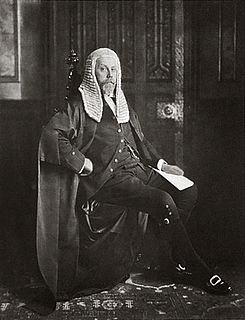This page is based on this
Wikipedia article Text is available under the
CC BY-SA 4.0 license; additional terms may apply.
Images, videos and audio are available under their respective licenses.
William Sinclair (1410–1484), 1st Earl of Caithness (1455–1476), last Earl (Jarl) of Orkney, Baron of Roslin, was a Norwegian and Scottish nobleman and the builder of Rosslyn Chapel, in Midlothian.

Earl of Lonsdale is a title that has been created twice in British history, firstly in the Peerage of Great Britain in 1784, and then in the Peerage of the United Kingdom in 1807, both times for members of the Lowther family.

Viscount Ullswater, of Campsea Ashe in the County of Suffolk, is a title in the Peerage of the United Kingdom. It was created in 1921 for James Lowther upon his retirement as Speaker of the House of Commons. He was the eldest son of the Hon. William Lowther, third son of the Hon. Henry Lowther, second son of William Lowther, 1st Earl of Lonsdale. The first Viscount lived to the age of 93, and was pre-deceased by both his eldest son the Hon. Christopher Lowther, a Conservative politician, and his eldest son's eldest son John Arthur Lowther (1910–1942), the title being inherited by his seven-year-old great-grandson, the second and current Viscount, in an extremely rare instance of a great-grandson succeeding his great-grandfather in a peerage. The second Viscount held office in the Conservative administrations of Margaret Thatcher and John Major and since 2003 he has been one of the ninety elected hereditary peers that remain in the House of Lords after the passing of the House of Lords Act 1999. As a descendant of the first Earl of Lonsdale he is also in remainder to this peerage and its subsidiary titles. The current holder of the earldom, Hugh Lowther, 8th Earl of Lonsdale, is Lord Ullswater's fourth cousin.

John Lowther, 1st Viscount Lonsdale, PC,, known as Sir John Lowther, 2nd Baronet, from 1675 to 1696, was an English politician.
John Stewart, 1st Earl of Atholl, also known as Sir John Stewart of Balveny, was a Scottish nobleman and ambassador.

There have been seven baronetcies created for members of the Lowther family, one in the Baronetage of Nova Scotia, two in the Baronetage of England, two in the Baronetage of Great Britain and two in the Baronetage of the United Kingdom. Two of the creations are extant as of 2008.

James Lowther, 1st Earl of Lonsdale was an English country landowner and politician who sat in the House of Commons for 27 years from 1757 to 1784, when he was raised to the Peerage of Great Britain as Earl of Lonsdale.
The Microbiology Society is a learned society based in the United Kingdom with a worldwide membership based in universities, industry, hospitals, research institutes and schools. It is the largest learned microbiological society in Europe. Interests of its members include basic and applied aspects of viruses, prions, bacteria, rickettsiae, mycoplasma, fungi, algae and protozoa, and all other aspects of microbiology. Its headquarters in Charles Darwin House, London. The society's current president is Prof. Judy Armitage. The Society is a member of the Science Council.
This is a list of people who have served as Lord Lieutenant of Cumberland. From 1765 to 1974, all Lord Lieutenants were also Custos Rotulorum of Cumberland.
This is a list of people who have served as Lord-Lieutenant of Westmorland. The office was abolished on 31 March 1974 and replaced by the Lord Lieutenant of Cumbria. From 1751 to 1974, all Lord Lieutenants were also Custos Rotulorum of Westmorland.
Gille Críst, Earl of Angus ruled until 1206 as Mormaer of Angus. He was a son of Gille Brigte of Angus and younger brother of Adam of Angus.

Sir Christopher Howard Andrewes was a British virologist who discovered the human influenza A virus in 1933.

Clan Lindsay is a Lowland Scottish clan.

William Lowther, 1st Earl of Lonsdale KG was a British Tory politician and nobleman.
This article summarises the relationships between various members of the family of Lowther baronets.

Smilin' Through is a 1941 Technicolor MGM musical film based on the 1919 play of the same name by Jane Cowl and Jane Murfin.
The Marjory Stephenson Prize is the principal prize of the Microbiology Society, awarded for an outstanding contribution of current importance in microbiology.

The Beit Memorial Medical Fellowships were one of the most prestigious and competitive fellowships for post-doctoral or medical degree research in medicine in the United Kingdom. The Fellowships were founded in 1909 by Sir Otto Beit, a German-born British financier, philanthropist and art connoisseur, in memory of his brother Alfred Beit.













